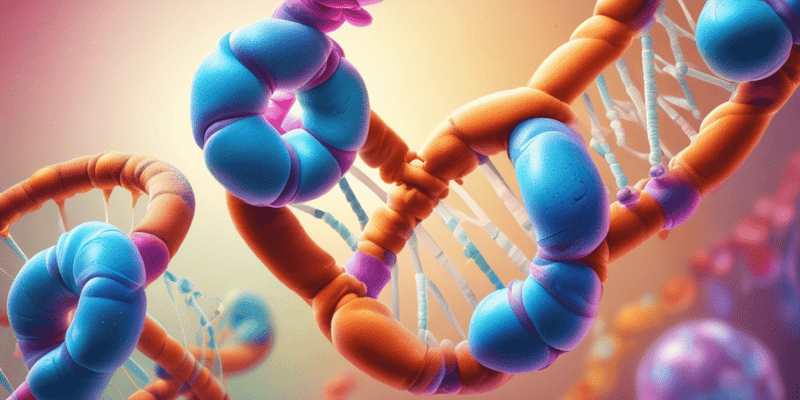9 Questions
What is the molecular basis for genes?
What is the function of transcription factors?
What is the difference between diploid and haploid organisms?
What is the role of epigenetic modifications?
What is the difference between mitosis and sexual reproduction?
What is the difference between the X and Y chromosomes?
What is the difference between genetics and genomics?
What is medical genetics?
What is the process of cancer development in the body?
Summary
Genetics is the study of genes, genetic variation, and heredity in organisms, and it is an important branch in biology because heredity is vital to organisms' evolution. The word genetics stems from the ancient Greek γενετικός genetikos meaning "genitive"/"generative." Trait inheritance and molecular inheritance mechanisms of genes are still primary principles of genetics in the 21st century, but modern genetics has expanded to study the function and behavior of genes. Organisms studied within the broad field span the domains of life (archaea, bacteria, and eukarya). Genetics has given rise to a number of subfields, including molecular genetics, epigenetics, and population genetics. Genetic processes work in combination with an organism's environment and experiences to influence development and behavior, often referred to as nature versus nurture. At its most fundamental level, inheritance in organisms occurs by passing discrete heritable units, called genes, from parents to offspring. The molecular basis for genes is deoxyribonucleic acid (DNA).Overview of DNA, genes, chromosomes, and genetic information
-
DNA is composed of deoxyribose, a phosphate group, and a base. There are four types of bases: adenine, cytosine, guanine, and thymine. These bases specifically pair together between two backbones and make like rungs on a ladder.
-
Genetic information exists in the sequence of nucleotides, and genes exist as stretches of sequence along the DNA chain. DNA chains coil into a double a-helix structure and wrap around proteins called Histones which provide the structural support. DNA wrapped around these histones are called chromosomes.
-
Genes are arranged linearly along long chains of DNA base-pair sequences. In bacteria, each cell usually contains a single circular genophore, while eukaryotic organisms have their DNA arranged in multiple linear chromosomes. These DNA strands are often extremely long; the largest human chromosome, for example, is about 247 million base pairs in length.
-
Most animals and many plants are diploid, containing two of each chromosome and thus two copies of every gene. The two alleles for a gene are located on identical loci of the two homologous chromosomes, each allele inherited from a different parent.
-
The Y chromosome contains the gene that triggers the development of specifically male characteristics. In evolution, this chromosome has lost most of its content and also most of its genes, while the X chromosome is similar to the other chromosomes and contains many genes.
-
When cells divide, their full genome is copied and each daughter cell inherits one copy. This process, called mitosis, is the simplest form of reproduction and is the basis for asexual reproduction.
-
Eukaryotic organisms often use sexual reproduction to generate offspring that contain a mixture of genetic material inherited from two different parents. The process of sexual reproduction alternates between forms that contain single copies of the genome (haploid) and double copies (diploid).
-
Genes generally express their functional effect through the production of proteins, molecules responsible for most functions in the cell. Proteins are made up of one or more polypeptide chains, each composed of a sequence of amino acids.
-
Although genes contain all the information an organism uses to function, the environment plays an important role in determining the ultimate phenotypes an organism displays.
-
The genome of a given organism contains thousands of genes, but not all these genes need to be active at any given moment. Transcription factors are regulatory proteins that bind to DNA, either promoting or inhibiting the transcription of a gene.
-
Differences in gene expression are especially clear in the various cell types of multicellular organisms. For example, neurons and muscle cells express different sets of genes despite having the same genome.
-
Epigenetic modifications of the DNA molecule, such as DNA methylation, can activate or silence gene expression.
-
RNA molecules can also have regulatory effects through hybridization interactions with other RNA molecules. These RNA molecules are called non-coding RNA.Genetics: An Overview
-
Multicellular organisms arise from a single cell, which differentiates into different cell types and establishes different patterns of gene expression to create different behaviors.
-
Epigenetic features, which are stably inherited by daughter cells, exist on top of the DNA sequence and retain inheritance from one cell generation to the next, and are responsible for different cell types retaining different properties.
-
Mutations are errors that occur during DNA replication, and can affect the phenotype of an organism, especially if they occur within the protein coding sequence of a gene.
-
Mutagenic processes increase the rate of changes in DNA, often by interfering with the structure of base-pairing, while UV radiation induces mutations by causing damage to the DNA structure.
-
Population genetics studies the distribution of genetic differences within populations and how these distributions change over time, and changes in the frequency of an allele in a population are mainly influenced by natural selection.
-
Medical genetics seeks to understand how genetic variation relates to human health and disease, and researchers commonly use genetic linkage and genetic pedigree charts to find the location on the genome associated with the disease.
-
Individuals differ in their inherited tendency to develop cancer, and cancer is a genetic disease, and the process of cancer development in the body is a combination of events.
-
Molecular cloning allows researchers to amplify the DNA fragments by inserting plasmids into bacteria and then culturing them on plates of agar.
-
DNA sequencing, one of the most fundamental technologies developed to study genetics, allows researchers to determine the sequence of nucleotides in DNA fragments.
-
Next-generation sequencing (or high-throughput sequencing) came about due to the ever-increasing demand for low-cost sequencing.
-
Genomics is the research that uses computational tools to search for and analyze patterns in the full genomes of organisms.
-
On 19 March 2015, a group of leading biologists urged a worldwide ban on clinical use of methods to edit the human genome in a way that can be inherited.
-
Chinese researchers reported results of basic research to edit the DNA of non-viable human embryos using CRISPR.
Description
Test your knowledge on genetics with this informative quiz! From the basics of DNA and genes to the advanced fields of epigenetics and population genetics, this quiz covers a wide range of topics. You'll learn about inheritance, mutations, genetic diseases, and the latest technologies used in genetic research. With multiple-choice questions and detailed explanations, this quiz is perfect for anyone interested in biology or genetics. Challenge yourself and see how much you really know about this fascinating field!


